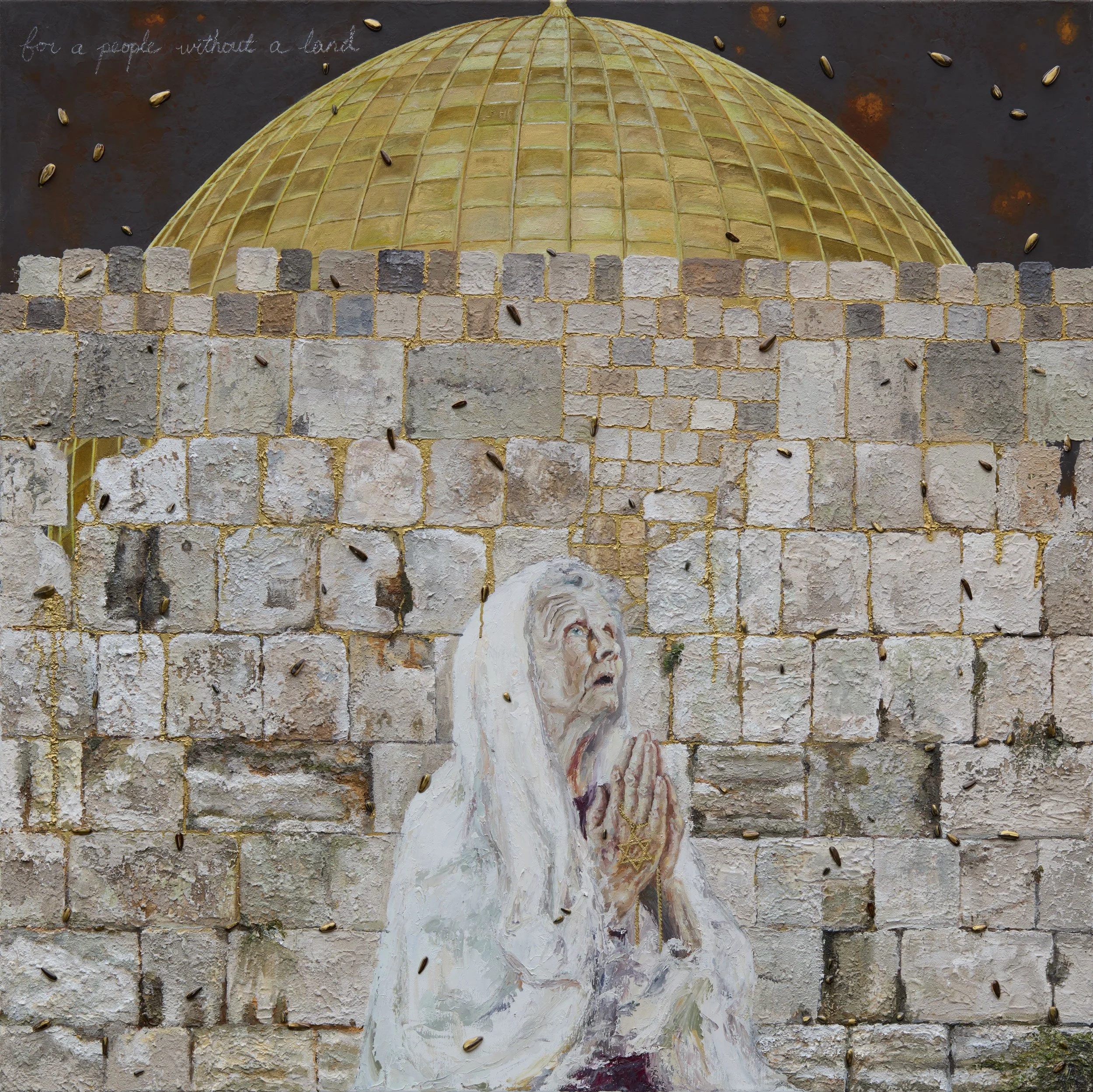A Tale of Two States (II)
枯榮 (二)
Oil, acrylic, sunflower seeds (in resin), sand, cement, plaster, paper, ash, bronze, iron, and crayon on canvas
Diptych,120 x 120cm (each) x 2, 2023–25
A Tale of Two States II (detail) 枯
Dec. 10, 2023
Starting over with “A Tale of Two States”, to tell his story.
Refaat Alareer, a Palestinian poet, writer, and literature professor, was killed three days ago by an Israeli airstrike in Gaza. Just last month, he posted this poem:
“ If I must die,
you must live
to tell my story
to sell my things
to buy a piece of cloth
and some strings,
(make it white with a long tail)
so that a child, somewhere in Gaza
while looking heaven in the eye
awaiting his dad who left in a blaze—
and bid no one farewell
not even to his flesh
not even to himself—
sees the kite, my kite you made,
flying up above
and thinks for a moment an angel is there
bringing back love
If I must die
let it bring hope
let it be a tale.”
A Tale of Two States II (detail) 榮
Dec. 25, 2023
The Sophists
“It doesn’t matter if justice is on your side. You have to depict your position as just.” –– Benjamin NetanyahuIn a report titled “The Israel Project’s 2009 – Global Language Dictionary,” Israeli spin doctor Frank Luntz wrote that to turn Israel “from bully to victim,” “the fight is over ideology–––not land; terror–––not territory.”
The sophists ––– what matters is not truth but rhetoric.
Postmodern art ––– what matters is not the work but the rhetoric.
What is missing here? The intrinsic value. What is the intrinsic value of Art?
A Tale of Two States II (detail)
Dec. 29, 2023
A surgeon in Gaza had to amputate his own child's limb without anesthetics, only to watch her die in excruciating pain. Earlier, a video showed a little boy screaming Quranic verses during surgery. UNICEF reports that since October 7, about 1,000 children in Gaza have had limbs amputated without anesthesia. Now, as they seek shelter from the raining bombs and bullets, they are left to grapple with cold, thirst, hunger, disease, and the desolation of their shattered world.
I hope that the three children I’ve painted for the “Tale” had already “left in a blaze—–and bid no one farewell, not even to their flesh, not even to themselves.” It’s too cruel to survive.
A Tale of Two States II (detail)
Jan. 11-12, 2024
War on Narrative
In The Hague, the International Court of Justice (ICJ) opened with South Africa accusing Israel—–a state built on the claim of surviving genocide—–of committing genocide.
The South African delegation presented an extremely compelling and heart-wrenching case, though most UK media, including the BBC, refused to broadcast it. The next day, the Israeli court response was covered everywhere.
Jan. 26, 2024
The ICJ ruling. 公道自在人心
A Tale of Two States II (detail)
Feb. 1, 2024
A sense of disappointment creeps in every time I finish a painting. My work is the only thing that makes me feel like myself. Everything else feels like a pretence. Art is more real than life.
But what, then, is Art? I have so much hope of catching it when I begin a work, but it always slips away by the time I’m done.
Is Art, like God, sui generis—–a category unto itself, beyond comprehension? If so, how can I know Art? Perhaps the answer lies not in abstraction, but in analogy.
Feb. 2, 2024
Not through Abstraction, But by Analogy
During the early weeks of the war in Gaza, I was in southern France. While sunbathing on the Côte d’Azur, I watched the massacre unfold across the sea, live on my phone. Out of habit, I visited the Musée Matisse, Musée Chagall, Musée Picasso, Fondation Maeght, and others. The modernist masters aimed for a child-like naïveté through strenuous abstraction. This time, in the face of war and the ocean, their work felt too light.
Since October 7, every boundary—geopolitical, moral, even aesthetic—seems to have shifted, including my own understanding of Art. I had never before contemplated the moral dimensions of Art. I grew up in China, where decades of moral hyperbole, hypocrisy, and ideological propaganda accustomed many to a disconnect between words and deeds, fostering a pragmatic, at times cynical, worldview. Our language and art were reduced to political tools, becoming formulaic, sentimental, and insincere. Because of this, I insist on believing—and still do—that beauty transcends good and evil, and that Art should exist for its own sake. Consequently, I eschewed any moral judgment in my work.
However, the war in Gaza has opened something within me. For the first time, I witnessed what I can only call “moral beauty” in a human soul. Brilliant intellectuals—Noam Chomsky, Jeffrey Sachs, John Mearsheimer, Norman Finkelstein, and Ilan Pappé—along with several remarkable journalists, have seen more malevolence and corruption than most. Yet, despite paying a personal price for their integrity, they maintained their moral courage. They did not turn cynical or despairing; instead, they remained steadfast in their commitment to truth and doing good. In them, I finally grasped what Confucius meant by 君子 (junzi, the noble or ideal man). Although 君子 has been extolled in Chinese education for over two millennia, I had never truly encountered one until now—perhaps due to my own blindness or the utilitarianism of my surroundings. The feeling I had, seeing the souls of these men, was as exalted as the tears brought to my eyes by the Parthenon sculptures.
For the first time, I began to ponder the Platonic Triad of higher Forms––truth, beauty, and justice––and the relationship between Art and morality.






